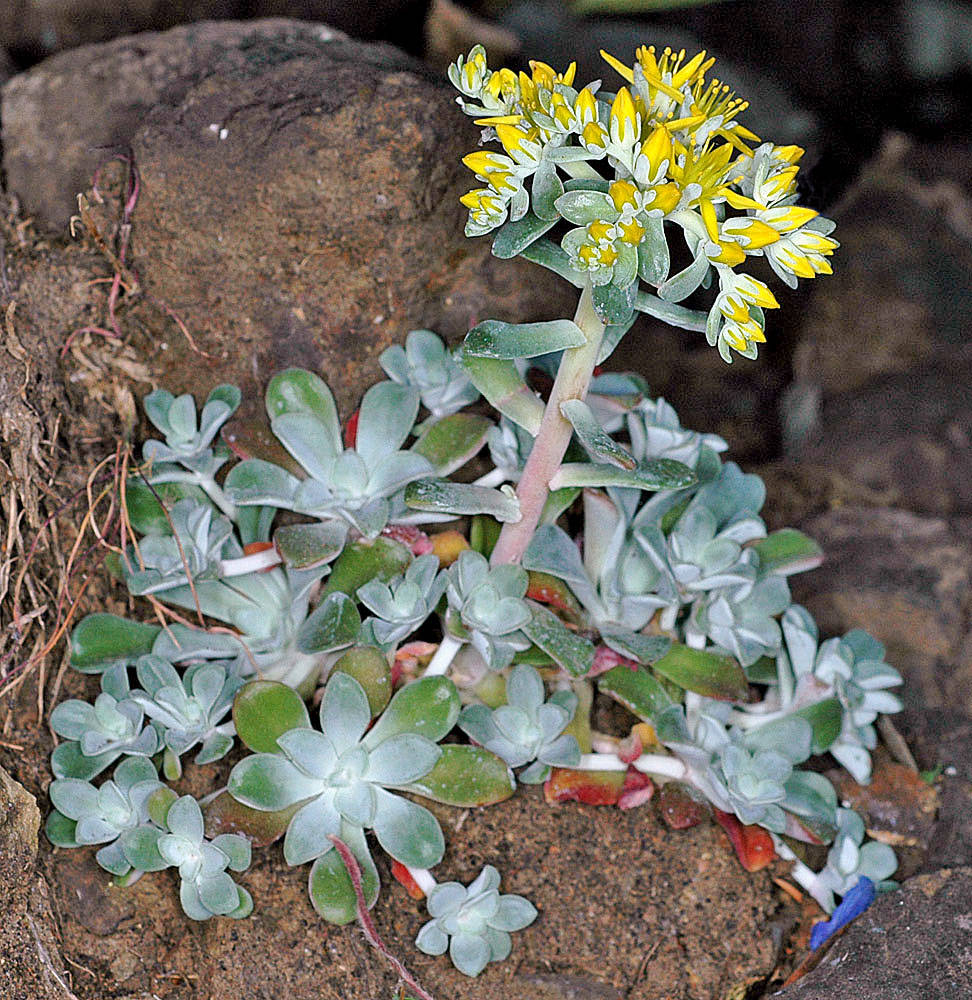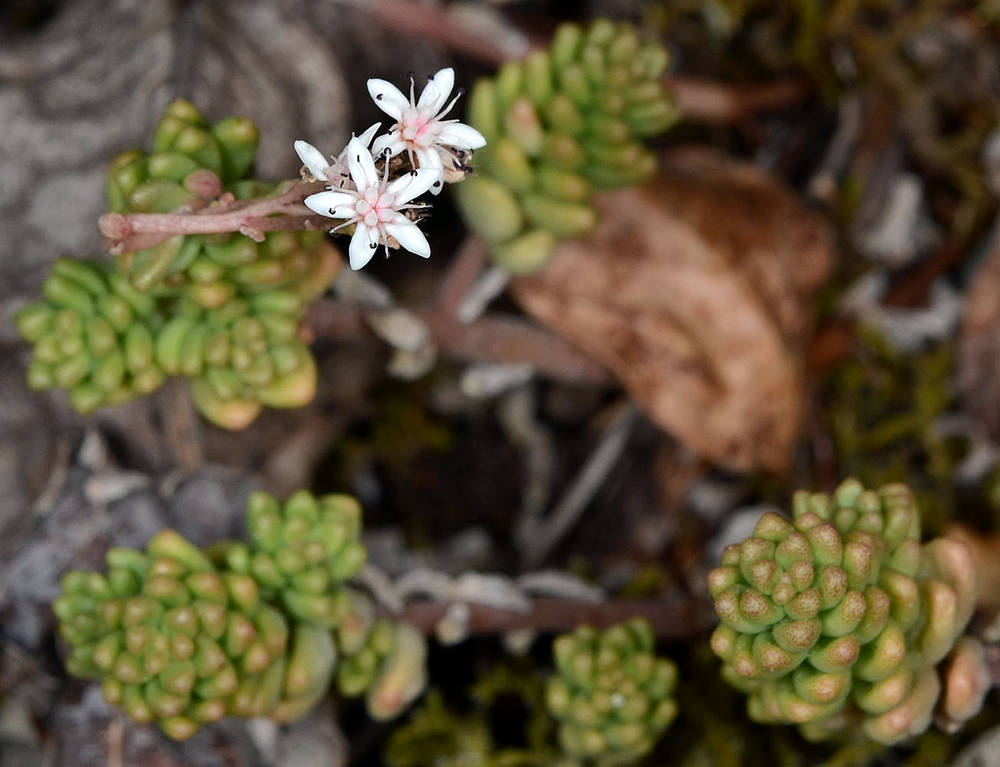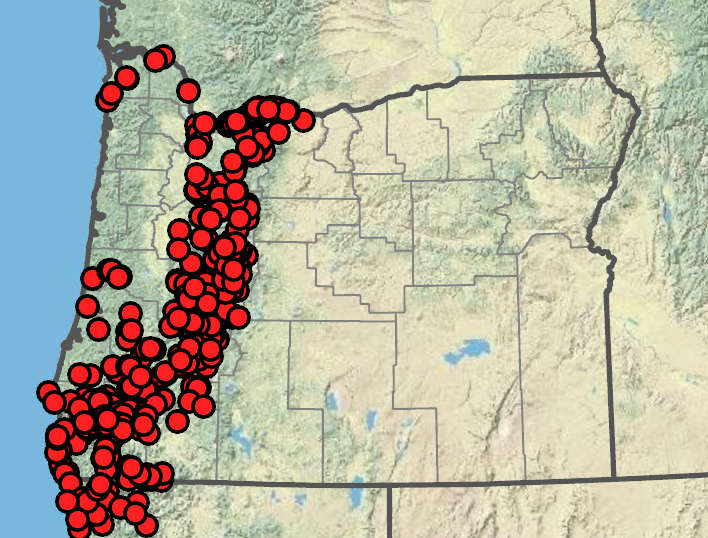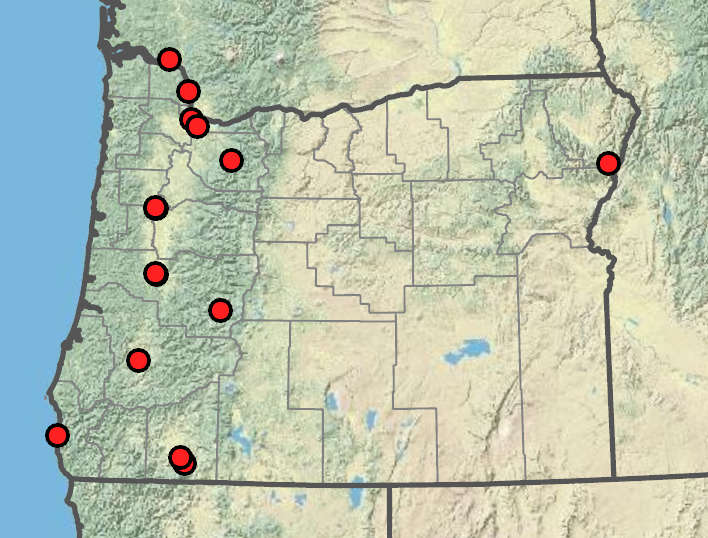Sedum spathulifolium
Sedum album
broadleaf stonecrop
white stonecrop
extensively stoloniferous, with dense terminal rosettes.
creeping or growing upwards, clustered and forming dense stands; much branched, minutely puberulent and papillose, densely but inconspicuously glandular toward base.
erect; simple, 3–14 cm;
stem leaves alternate, spatulate-oblong or elliptic-oblong; widest at or below middle, different from rosette leaves.
erect; simple or branched, 5–18(30) cm, glabrous or sparsely minutely hairy;
stem leaves alternate, linear to ovate; broadest below middle or parallel-sided, similar to other leaves.
rosette leaves spreading, usually nearly parallel to ground, usually forming flat rosettes, spatulate, narrowing to petioles, 7–19 × 4.5–10 mm, 5 × as wide as thick, green or pruinose and white, bases not spurred, not scarious, sometimes muricate or papillose near margins;
tips rounded or truncate;
surfaces usually glaucous.
spreading to appressed, linear to ovate, 4–20(25) × 1–20 mm, green to reddish; thick, bases not or slightly spurred;
margins entire or low-papillose;
tips obtuse to rounded; papillae < 0.1 mm;
surfaces glabrous or with sparse hairs generally < 0.1 mm;
basal leaves approximately as wide as thick; on ascending leafy shoots, sessile.
cymes with ~30 flowers, 3-branched;
branches forked;
bracts oblong-spatulate or linear.
panicle-like cymes with 15–50+ flowers, 3–5-branched;
bracts similar to leaves but smaller.
5-parted;
sepals spreading to erect, lanceolate, linear-lanceolate, oblong-ovate or obovate; ~2.5 × 1.5 mm, green to yellow-green;
tips acute or obtuse;
surface glaucous or pruinose;
petals strongly spreading above erect base, linear to oblanceolate, 4.5–9 mm, yellow;
tips acute;
filaments yellow;
anthers yellow.
5-parted;
sepals erect, 0.5–1.5 × 0.2–0.5 mm, green;
tips acute;
petals spreading, lanceolate, 2–4.5 mm, white or rarely pink;
tips ± acute;
filaments white;
anthers dark red or dark purple.
erect until mature then spreading, fused basally, brown.
erect, white.
=34, 51, 68, 102, 136.
Sedum spathulifolium
Sedum album
Rocks, cliffs and road cuts. Flowering Apr–Aug. 0–2400 m. Casc, Col, CR, ECas, Est, Sisk, WV. CA, WA; north to British Columbia. Native.
Sedum spathulifolium is highly variable. If subspecies are recognized, most of our plants are S. spathulifolium ssp. spathulifolium. A coastal form with thick, white-pruinose leaves, short, stout stolons, dense inflorescences and thick, crowded stem leaves can be called S. s. ssp. pruinosum (if it is considered a strictly coastal entity). If it is considered to include strongly glaucous or pruinose plants of the Coast Range that are less dense in growth form, the name S. s. var. minus would be applied. Plants with thin, green leaves, numerous long, slender stolons that tend to grow upwards before growing out, paler flowers, and more spreading follicles can be called S. s. ssp. purdyi, a rare form known only from southern Josephine County, and Del Norte and Siskiyou counties in California.
Disturbed places, trail sides, old house sites, sidewalks, gravel parking lots, coastal salt marshes, coastal rocks. Flowering Jul–Aug. 0–1400 m. BW, Casc, Sisk, WV. CA, WA; north to British Columbia, northeast to MT, southeast to UT, ME; Europe. Exotic.
Sedum album is a familiar cultivated succulent with white flowers. Many populations are stubbornly persistent in sites with sandy or gravelly soil where competition from other perennial plants is minimized. Populations in coastal marshes and rocks seem to be spreading.
Barbara Wilson, Richard Brainerd, Nick Otting
Barbara Wilson, Richard Brainerd, Nick Otting
- Local floras:
BC,
CA,
OR,
WA
- Local Web sites:
CalFlora,
CalPhotos,
Flora NW,
PNW Herbaria,
Turner Photog.
WildflowerSearch
iNaturalist (observations)
USDA Plants Database
- LBJ Wildflower Center
- SEINet
- Plants of the World Online
- Encyclopedia of Life
- Wikipedia
- Google Image Search
- Local floras:
BC,
CA,
OR,
WA
- Local Web sites:
CalFlora,
CalPhotos,
Flora NW,
PNW Herbaria
WildflowerSearch
iNaturalist (observations)
USDA Plants Database
- LBJ Wildflower Center
- SEINet
- Plants of the World Online
- Encyclopedia of Life
- Wikipedia
- Google Image Search





